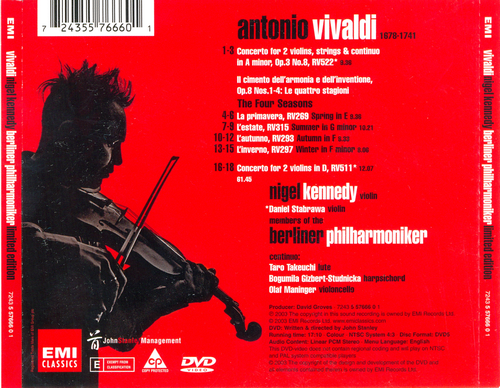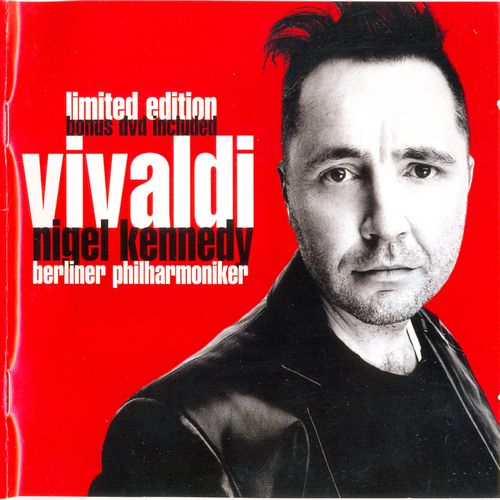
Nigel Kennedy, Berliner Philarmoniker - Antonio Vivaldi (2003) CD-Rip
BAND/ARTIST: Nigel Kennedy, Berliner Philarmoniker
- Title: Antonio Vivaldi
- Year Of Release: 2003
- Label: EMI Classics
- Genre: Classical
- Quality: FLAC (image+.cue,log,scans)
- Total Time: 01:01:45
- Total Size: 369 Mb
- WebSite: Album Preview
Tracklist:
Concerto for 2 violins, strings & continuo in A minor, Op.3 No.8, RV522*
1: Allegro 2.54
From Nigel Kennedy: 'This is strong, vibrant writing with refined touches. The forward energy of this movement is unrelenting.'
2. II: Larghetto e spirituoso 4.11
'In my opinion this is one of Vivaldi's most successful melodic movements. The two solo violins alternate between hushed conversational melodies and unanimous harmony over a hypnotic ostinato that has a feeling of introversion and timelessness.'
3. III: Allegro 2.31
'A fitting finale for any concerto. Virile and virtuosic playing is required from soloists and orchestra alike. Exciting and fast'
4. I: Allegro 3.05
'Big blocks of sound alternate with either virtuosic solo displays or with small chamber groups around the soloist. The freshness and life of Spring are evoked by this imaginative writing.'
5. II: Largo 2.30
'A more introspective and concentrated feeling is evoked by the beautiful orchestration which, interestingly, doesn't use the cello and bass section.'
6. III: Allegro 4.01
'Energetic dance rhythms prevail here apart from a magic moment towards the end of the movement, when Vivaldi breaks it down to just violin and cello before returning to the original mood of festive spirit. There are details of festive spirit and of characterisation well worth listening to in the orchestra.'
7. I: Allegro non molto - Allegro - (Allegro non molto) 5.16
'Open space is evoked by the introduction. An unpleasant, uncomfortable Summer's day is portrayed by the tonality and schizophrenic tendencies of this movement. It is hard to imagine that Vivaldi enjoyed the Summer season when playing this music.'
8. II: Adagio 2.26
'Slow solo passages of a personal, emotional nature are interrupted by orchestral simulations of thunder. Unusually, the quiet mood prevails at the end.'
9. III: Presto 2.39
'Hard, aggressive sixteenth notes push almost literally non-stop through this movement, whether it is the struggling solo violin or the strong, driving, relentless orchestra.'
L'autunno (Autumn), RV293 in F
10. I: Allegro - Larghetto - Allegro assai 2.08
'Vivaldi's talent for dance rhythms returns. The feeling of comrades having a good party is well captured here. Seriously beautiful music of a quieter nature (again minus cellos and basses) gives way to a humourous recall of the movement's main energy.'
11. II: Adagio molto 2.52
'A feeling of transfiguration available only through the sub-conscious is evoked here. The weightless feeling is achieved by long, sustained writing for the strings with subtle one-note changes achieving harmonic transformations.' /i]
12. III: Allegro 3.33
'Here are more dance rhythms, but the movement becomes progressively more macabre until the important moment of the soul leaving the hunted animal's body. Another lightly humourous ending. A lot of fun is enjoyed between the cello and solo violin in this movement, which is never played exactly the same way twice.'
L'Inverno (Winter), RV297 in F minor
13. I: Allegro non molto 3.02
'Yet again, it is striking that with ideas of such contrasting natures, Vivaldi achieves a movement of strong individual identity. Energy is again a unifying concept for Vivaldi's virile writing.'
14. II: Largo 1.39
'Another beautiful solo melody - but it is just as interesting to listen to the orchestra. Long, sustained notes, representing warmth, pizzicato notes representing raindrops and fast cello notes symbolise energy.'
15. III: Allegro - Lento - (Allegro) 3.25
'There is a slightly nervous lonely feel at first before aggression takes over. Another really personal section precedes the high-energy virtuoso finale.'
'When finishing this set of concertos as the solo violinist/director, it is always impressive how much rapport this work helps you achieve with individual members of the orchestra, as well as the orchestra as a whole. On this occasion this was even more evident because of the amazing talent of every individual player in the Berlin Philharmonic.'
Concerto for 2 violins in D, RV511*
16. I: Allegro molto - Adagio - Allegro 4.37
This work is in many ways more sophisticated than the other concertos. The first movement is very theatrical, with an operatic feel - the two solo violins taking on the role of two superhuman coloraturas. As always, the mood changes are remarkable, particularly as they happen in such a short time. A good moment for Daniel and me to show off!'
17. II: Largo 3.52
'A very ornate, decorative movement. Unlike many of Vivaldi's slow movements, melody is not of primary importance here. Matters of style dominate, a bit like a very ornate dinner party with polite society (to which I might not be invited!).'
18. III: Allegro 3.38
'A more straightforward movement with writing in which Daniel and I can enjoy some co-ordinated passage work with a bit of light-hearted competition.'
Performers:
Nigel Kennedy - Violin
*Daniel Stabrava - violin
members of the Berliner Philarmoniker
Taro Takeuchi - lute
Bogumila Gizbert-Studnicka - harpsichord
Olaf Maninger - violoncello

Concerto for 2 violins, strings & continuo in A minor, Op.3 No.8, RV522*
1: Allegro 2.54
From Nigel Kennedy: 'This is strong, vibrant writing with refined touches. The forward energy of this movement is unrelenting.'
2. II: Larghetto e spirituoso 4.11
'In my opinion this is one of Vivaldi's most successful melodic movements. The two solo violins alternate between hushed conversational melodies and unanimous harmony over a hypnotic ostinato that has a feeling of introversion and timelessness.'
3. III: Allegro 2.31
'A fitting finale for any concerto. Virile and virtuosic playing is required from soloists and orchestra alike. Exciting and fast'
4. I: Allegro 3.05
'Big blocks of sound alternate with either virtuosic solo displays or with small chamber groups around the soloist. The freshness and life of Spring are evoked by this imaginative writing.'
5. II: Largo 2.30
'A more introspective and concentrated feeling is evoked by the beautiful orchestration which, interestingly, doesn't use the cello and bass section.'
6. III: Allegro 4.01
'Energetic dance rhythms prevail here apart from a magic moment towards the end of the movement, when Vivaldi breaks it down to just violin and cello before returning to the original mood of festive spirit. There are details of festive spirit and of characterisation well worth listening to in the orchestra.'
7. I: Allegro non molto - Allegro - (Allegro non molto) 5.16
'Open space is evoked by the introduction. An unpleasant, uncomfortable Summer's day is portrayed by the tonality and schizophrenic tendencies of this movement. It is hard to imagine that Vivaldi enjoyed the Summer season when playing this music.'
8. II: Adagio 2.26
'Slow solo passages of a personal, emotional nature are interrupted by orchestral simulations of thunder. Unusually, the quiet mood prevails at the end.'
9. III: Presto 2.39
'Hard, aggressive sixteenth notes push almost literally non-stop through this movement, whether it is the struggling solo violin or the strong, driving, relentless orchestra.'
L'autunno (Autumn), RV293 in F
10. I: Allegro - Larghetto - Allegro assai 2.08
'Vivaldi's talent for dance rhythms returns. The feeling of comrades having a good party is well captured here. Seriously beautiful music of a quieter nature (again minus cellos and basses) gives way to a humourous recall of the movement's main energy.'
11. II: Adagio molto 2.52
'A feeling of transfiguration available only through the sub-conscious is evoked here. The weightless feeling is achieved by long, sustained writing for the strings with subtle one-note changes achieving harmonic transformations.' /i]
12. III: Allegro 3.33
'Here are more dance rhythms, but the movement becomes progressively more macabre until the important moment of the soul leaving the hunted animal's body. Another lightly humourous ending. A lot of fun is enjoyed between the cello and solo violin in this movement, which is never played exactly the same way twice.'
L'Inverno (Winter), RV297 in F minor
13. I: Allegro non molto 3.02
'Yet again, it is striking that with ideas of such contrasting natures, Vivaldi achieves a movement of strong individual identity. Energy is again a unifying concept for Vivaldi's virile writing.'
14. II: Largo 1.39
'Another beautiful solo melody - but it is just as interesting to listen to the orchestra. Long, sustained notes, representing warmth, pizzicato notes representing raindrops and fast cello notes symbolise energy.'
15. III: Allegro - Lento - (Allegro) 3.25
'There is a slightly nervous lonely feel at first before aggression takes over. Another really personal section precedes the high-energy virtuoso finale.'
'When finishing this set of concertos as the solo violinist/director, it is always impressive how much rapport this work helps you achieve with individual members of the orchestra, as well as the orchestra as a whole. On this occasion this was even more evident because of the amazing talent of every individual player in the Berlin Philharmonic.'
Concerto for 2 violins in D, RV511*
16. I: Allegro molto - Adagio - Allegro 4.37
This work is in many ways more sophisticated than the other concertos. The first movement is very theatrical, with an operatic feel - the two solo violins taking on the role of two superhuman coloraturas. As always, the mood changes are remarkable, particularly as they happen in such a short time. A good moment for Daniel and me to show off!'
17. II: Largo 3.52
'A very ornate, decorative movement. Unlike many of Vivaldi's slow movements, melody is not of primary importance here. Matters of style dominate, a bit like a very ornate dinner party with polite society (to which I might not be invited!).'
18. III: Allegro 3.38
'A more straightforward movement with writing in which Daniel and I can enjoy some co-ordinated passage work with a bit of light-hearted competition.'
Performers:
Nigel Kennedy - Violin
*Daniel Stabrava - violin
members of the Berliner Philarmoniker
Taro Takeuchi - lute
Bogumila Gizbert-Studnicka - harpsichord
Olaf Maninger - violoncello

Classical | FLAC / APE | CD-Rip
As a ISRA.CLOUD's PREMIUM member you will have the following benefits:
- Unlimited high speed downloads
- Download directly without waiting time
- Unlimited parallel downloads
- Support for download accelerators
- No advertising
- Resume broken downloads


